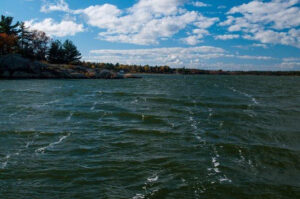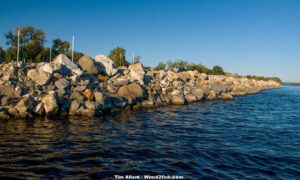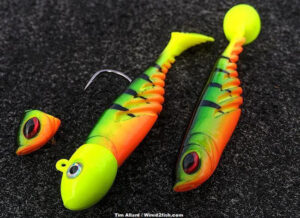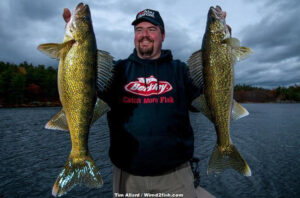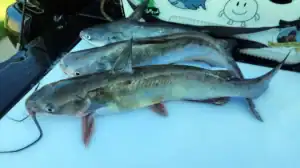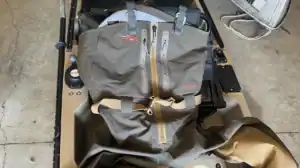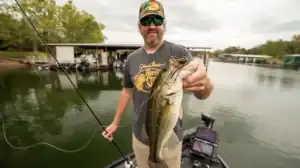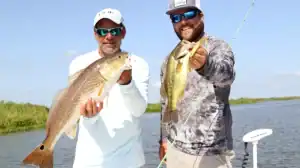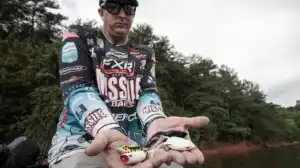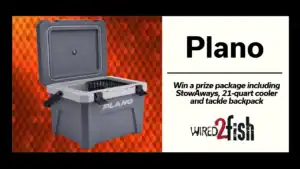Conventional wisdom says walleyes go deep in the fall. Humps, bars and other structures near basins become prime real estate following turnover. Without question, deep haunts attract walleye, but according to Chris Hockley shallow areas deserve attention.
Currently, Hockley serves as Brand Marketing Manager for Berkley. Before this he guided for 21-years on Ontario’s fertile Kawartha lakes. In this time, he observed a consistent shallow-water pattern for walleye from turnover to mid autumn in the Kawarthas and other systems in Ontario, including Georgian Bay and Bay of Quinte. The equation is simple: Walleyes move shallow to exploit abundant forage when conditions are to their advantage.
Here are some things anglers should consider when pursuing walleyes in the shallows during fall:
- Turnover timing
- The frog factor
- Weather plays a role
- Shallow spots
- Tactics
- Color considerations
Turnover timing
Turnover begins the shallow-walleye pattern. The thermocline is eliminated when warm and cold layers of water mix.
“Turnover is like someone’s blown up a walleye’s house,” Hockley said. “Everything is in turmoil. Walleye are cruising. You can’t sugar coat it; you’ve got to move to find walleye. Once you find them, they’re often grouped up tight. One of the first places I look is shallow water.”
Immediately prior to, during and following turnover, shallow areas become feeding zones for walleye. Cool-water fish like walleye can and do move shallow to feed on baitfish that have done the same.
Once, the habitat becomes inhospitable, walleye leave the shallows for deeper haunts.
“If you go up shallow and the weeds are all dead and nothing’s moving, it’s too late. You need to move deep,” said Hockley.
The frog factor
From late summer into mid-autumn, northern leopards leave their summertime terrestrial habitats to burrow in the bottom of lakes and rivers for the winter. The boom of frogs attracts walleye.
“The walleye are up shallow because of the frogs, but walleye will eat anything. You don’t need to switch to anything froggy looking to catch them,” said Hockley.
Driving side roads along lakes at night is a reliable way to track the migration. When it’s on, frogs are all over the road. That’s the sign to get on the water.
Weather plays a role
Even with ample forage, shallow-water patterns are a tenuous affair influenced by weather. Overcast, wet, rainy and windy days make for great shallow-water walleye fishing, provided conditions remain stable.
The perfect situation for shallow walleye in autumn is stable weather. Cold fronts will really mess with fish. Once it gets cold, it’s not the cold that turns-off walleye, it’s the weather changes..
Shallow spots
Abundant forage is a basic ingredient for shallow-water walleye in autumn. Hockley’s found the best areas provide walleye a hunting advantage. Here are 5 great walleye spots for fall:
- Healthy weeds – In the shallows during fall, there are weeds dying off in various forms, from wilting to completely brown. But, you can often find isolated clumps of green weeds. Finding healthy weeds is key for shallow walleye. Walleye may be in the weeds for the shade because they’re light sensitive. Or they may be pushing bait up against the weeds when feeding.
- Wind-pounded structure – When you get a wind blowing up against an obstruction, like a point, it works-up the walleye into a feeding frenzy. When the wind and waves make a froth on the shoreline, those are the right conditions. You don’t need to finesse walleye with a jig. You can use a crankbait or jerkbait and they’ll crush it. They’ll be eating baitfish, crayfish, frogs and anything else that moves.
- Walls – Fish break walls around marinas and concrete or riprap walls around cottages. Walleye push baitfish up against these walls to feed, especially when there’s wind and waves pounding on it.
- Steep, shallow breaks – Something similar to a wall is a steep drop near a shallow flat close to shore. A shallow mid-lake hump with a steep drop is another spot where walleye push baitfish. A distinct outside weed edge can also act like a wall.
- Gently sloping shorelines – Gentle sloping shorelines near grassy or marshy areas attract walleye during the frog migration. Openings in bulrushes in front of large fields are travel routes for frogs and will concentrate walleye. Areas immediately adjacent to deep water are ideal. Bays and flats in front of marshes are also good.
Tackle and tactics
Hockley favors fast, reaction-style baits to appeal to the aggressive mood of walleye foraging shallow. Finesse tactics become a last resort.
- Shad crankbaits – A shad crankbait, like a Berkley Flicker Shad, is great for covering water. Crank it down, let it tick weeds, back off and let it float up. It doesn’t have to be grinding bottom. As long as your ticking or side swiping weeds, you’re doing it right..
- Hard jerkbaits – “I used to catch a lot of walleye on typical bass-style jerkbaits that had a conservative action,” Hockley said. “I’d often use a twitch-twitch-pause retrieve. Then change the tempo based on how walleye bit. Slower was generally better most days.”
- 4- to 6-inch swimbaits – A swimbait goes through cover better than a jerkbait. It’s a single hook versus 3 treble hooks. The other advantage of a swimbait is you can drop it. If you see a walleye following, you can let it fall, and a lot of times walleye will hit. Then there’s the ‘flap, flap, flap’ of that big swimming tail. Those vibrations stir up walleye and makes them bite.
- Lipless cranks – A lipless crankbait allows you to cover a lot of water with a lot of noise for scattered fish. Don’t get fancy. Just chuck them out and wind them in. A nice thing about a lipless crank is you can rip it through weeds if you get hung up, which can also trigger strikes.
- Spinnerbaits – They go through weeds well. Their flash and thump attract walleye. Use a big Colorado-blade spinnerbait. It moves so much water and helicopters down when paused. There’s always some action to it.
- Float and jig twitch – When reaction baits aren’t getting bites, go with a slip-float and 1/4- to 3/8-ounce jig with a grub or minnow beneath it. Work the bait aggressively, jerking it, then letting it sit to call-out fish hiding in weeds or cruising around them. This isn’t a finesse float tactic. If this approach fails, Hockley ditches the float and tries a subtle swimming or a yo-yo retrieve with a jig.
Color considerations
“I pick colors depending on water clarity,” Hockley said. “Walleye like brighter colors, so for hard-baits I’ll start with fire tiger or Racy Shad, then dial back to a neutral shad, if needed. Kawartha walleye often feed on lake shiners and golden shiners, so I also use a broken up chrome, black-silver and black-gold. For soft-baits, I fish a lot of chartreuse, white, hot pink and orange patterns. White and chartreuse or black and silver tinsel were my top spinnerbait skirts.”
Also, read our article on Best Walleye Lures.
The shallow-water walleye bite in fall boils down to ample feeding opportunities. Before the food chain slides deep for winter, give the shallows a try. These areas can hold huge quantities of hungry, and often overlooked, walleye.

